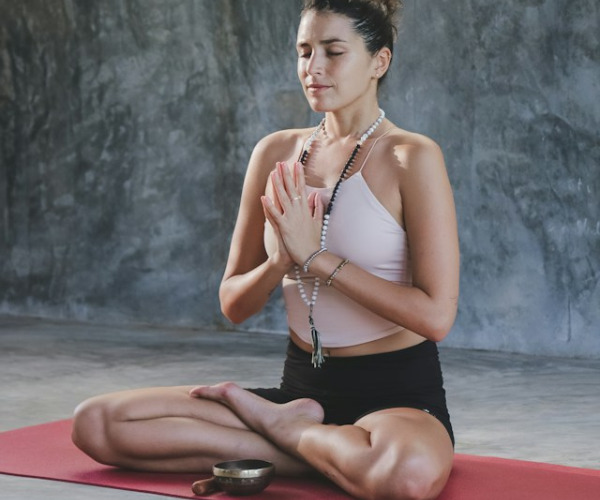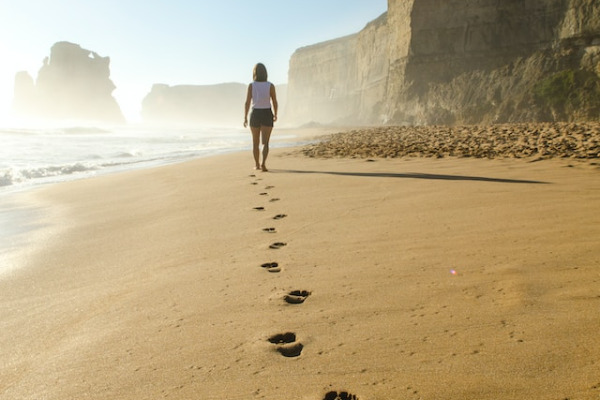Mental Health • 02/15/2023
3 Mindfulness Activities for Anxiety

Revivalist is a reader-supported endeavor and our posts may contain affiliate links. When you buy through links on our site, we may earn an affiliate commission.
Anxiety is much more than feeling afraid. This condition can cause considerable dysfunction in daily life, driving poor decision-making and maladaptive behaviors that lead to future problems — and more reasons to panic. Fortunately, there are self-help remedies you can turn to if you’re one of the many who can’t afford prescription medications or regular therapist visits. Try incorporating these five mindfulness activities for anxiety into your routine and see if they bring you relief.
1. Breathe Three

For thousands of years, Yogis have understood the importance of pranayama, or breathwork. Your breath has the power to change your physiological processes, helping to stabilize your mood by directly addressing the overreaction of your central nervous system and the peripheral organs and hormonal and neurotransmitters it activates.
To understand why breathing is so powerful, it helps to know what happens in your body when you panic. Here’s a brief rundown of some of the processes that occur when you experience a stimulus that invokes present or past fear:
- Your amygdala senses danger: This almond-shaped brain region determines if something is worth attention. It shrinks in individuals with trauma history, which scientists believe might explain why they overreact to certain stimuli.
- Your HPA axis sounds the alarm: Your HPA axis is your hypothalamus-pituitary-adrenal axis. Think of it in your body’s alarm system. In people with trauma histories, it fails to function as it should. It’s constantly signaling the alert, which people sometimes ignore, seeming flat and unaffected — until they explode.
- You ramp up adrenaline and cortisol production: These stress hormones give you energy for fight or flight by prompting physiological changes like heart rate and respiration increase and gastrointestinal action slows down. Cortisol picks up where adrenaline leaves off. Levels often remain elevated in people under constant stress, leading to health problems.
Anxiety rates increased precipitously during the recent pandemic. However, despite the sharp uptick in mental health needs, less than half of Americans get the treatment they need to manage their conditions. You can do breathwork if you’re not ready to face a therapist yet. No one has to know what you’re doing. Although you can find dozens of pranayama techniques, try combining these three to quell panic.
The Big Sigh
Inhale as deeply as you can. Feel your belly and chest expand as you stretch them as far as you can. Pause and exhale with a huge sign. You might even shake your upper a few times as if trying to brush that tension right off your shoulders. Repeat two or three times.
Equal Breathing
This technique is easy to remember — it’s nearly as natural as sighing. However, it allows you to start slowing the increased respiration that occurs when you experience fear, the physiological chain of events that can lead to a negative feedback loop of spiraling panic.
All you have to do is inhale for a 5-count and exhale for a 5-count. Repeat for several moments, tuning into your heart’s center and paying attention to how fast it beats. Continue until you start to feel the rhythm feel more natural.
2-to-1 Breathing
Slightly elongating your exhales activates your body’s parasympathetic response, the side that tells you it’s time to relax. That’s what you want to calm panic. Begin by slightly elongating your exhales. Your goal is to make them twice as long as your inhales, but don’t get too hung up on the count. Some people prefer a 4/8 count, while others do better with a 3/6.
2. Fast-Slow Walking

Walking can be one of the ultimate mindfulness activities for anxiety. Playing with pace helps you tap into your body’s innate fight-or-flight reflex, dispelling excess cortisol the way nature intended before inducing a sense of calm.
Begin with speed-walking. Stride as quickly as you can. As you do, pay attention to your body. Can you feel your breath coming fast and hard? Can you sense your heart starting to pound? Are you breaking a sweat? In this stage, you’re dispelling that excess adrenaline and cortisol as you mindfully pay attention to your physiological state. Continue until you reach the point of fatigue, not exhaustion.
Then, slow your pace. Start to shift your focus from your body to your mind. You might do so by beginning with your initial five senses, noticing what you can see, hear, feel, smell and touch. Move on to the other, deeper ones — what word would you use to describe your emotional state? Reflect on what happened just before you felt triggered. Are you reacting to the present or your past?
Once you identify your emotional state, you can think more objectively about solutions. However, take a moment simply to feel your feet connecting with the earth first. Breathe and express gratitude — how glorious it is to be able to walk. Thankfulness helps you realign your mindset and see your situation more clearly.
3. The Closet Cleanout

Can cleaning be a mindfulness activity for anxiety? Absolutely. Why? Excess clutter bombards your brain with extra stimuli — it’s like having your boss dangle a never-ending to-do list before your eyes 24/7.
However, it can be overwhelming to tackle everything if you’ve let your home go to pot. Taking a step-by-step approach is best, focusing on one small area at a time. Here’s how to adjust your mindset when you do:
- Set an intention: It might be something like, “I have the power to create harmony in my environment,” or, “Today, I take control of what bothers me one step at a time.” Meditate on it for a minute, feeling in your heart’s center that, yes, you can master this mess. Say it out loud.
- Be systematic: When clearing clutter, create three piles. One is to keep, and the other two are to donate or sell and recycle or trash.
- Get brutal: Energetically dive into your cleaning — remember, physical movement dispels excess cortisol. Here’s why it’s best to focus on one small area at a time. You don’t want to overwhelm yourself or feel like you did another shoddy job because you felt rushed. Do a thorough job, getting it just how you like it the first time.
This mindfulness activity for anxiety benefits you in multiple ways. It helps restore your sense of agency, your belief that your actions make a meaningful difference in your world. It gets you moving while removing an ongoing stressor from your mind. Plus, you get rewarded with a clean house.
Mindfulness Activities for Anxiety
Anxiety can cause severe disruptions in your everyday life and cause considerable suffering. Unfortunately, many people go without the help they need.
Fortunately, there are self-help remedies available. Consider these three mindfulness activities for anxiety the next time you feel panicky and restore your sense of calm.
Subscribe to Our Weekly Newsletter
We would love to connect deeper with you!


